Bioactivity-Guided Identification of Anti-Adipogenic Isothiocyanates in the Moringa (Moringa oleifera) Seed and Investigation of the Structure-Activity Relationship
Abstract
1. Introduction
2. Results and Discussion
2.1. Bioactivity-Guided Isolation of Potential Anti-Adipogenic Compounds from Moringa Seeds
2.2. Structure Elucidation of Compounds 1 and 2 from Moringa Seeds
2.3. Anti-Adipogenic Effects of Purified Compounds
2.4. Structure-Activity Relationship of Isothiocyanate (ITC) Derivatives
3. Materials and Methods
3.1. Materials
3.2. LC-MS Analysis
3.3. NMR Analysis
3.4. Purification of Compounds 1 and 2
3.5. Anti-Adipogenic Activity Assay
3.6. Cytotoxicity Assay
3.7. Statistical Analysis
4. Conclusions
Supplementary Materials
Author Contributions
Funding
Conflicts of Interest
References
- Kopelman, P.G. Obesity as a medical problem. Nature. 2000, 404, 635–643. [Google Scholar] [CrossRef]
- Kang, J.G.; Park, C.Y. Anti-obesity drugs: A review about their effects and safety. Diabetes Metab. J. 2012, 36, 13–25. [Google Scholar] [CrossRef]
- Jeong, G.H.; Cho, J.H.; Kim, S.H.; Kim, T.H. Plasma-induced dimerization of phlorizin as a new class of anti-adipogenic agents. Bioorg. Med. Chem. Lett. 2017, 27, 4889–4892. [Google Scholar] [CrossRef]
- Yun, J.W. Possible anti-obesity therapeutics from nature – A review. Phytochem. 2010, 71, 1625–1641. [Google Scholar] [CrossRef]
- Anwar, F.; Latif, S.; Ashraf, M.; Gilani, A.H. Moringa oleifera: A food plant with multiple medicinal uses. Phytother. Res. 2007, 21, 17–25. [Google Scholar] [CrossRef]
- Amaglo, N.K.; Bennett, R.N.; Lo Curto, R.B.; Rosa, E.A.S.; Lo Turco, V.; Giuffrida, A.; Lo Vurto, A.; Grea, F.; Timpo, G. Profiling selected phytochemicals and nutrients in different tissues of the multipurpose tree Moringa oleifera L., grown in Ghana. Food Chem. 2010, 122, 1047–1054. [Google Scholar] [CrossRef]
- Makkar, H.P.S.; Becker, K. Nutrients and antiquality factors in different morphological parts of the Moringa oleifera tree. J. Agri. Sci. 1997, 128, 311–322. [Google Scholar] [CrossRef]
- Ragasa, C.Y.; Ng, V.A.S.; Shen, C.C. Chemical constituents of Moringa oleifera Lam. seeds. Int J. Pharmacogn Phytochem. Res. 2016, 8, 495–498. [Google Scholar]
- Gopalakrishnan, L.; Doriya, K.; Kumar, D.S. Moringa oleifera: A review on nutritive importance and its medicinal application. Food Sci. Human Wellness 2016, 5, 49–56. [Google Scholar] [CrossRef]
- Stohs, S.J.; Hartman, M.J. Review of the safety and efficacy of Moringa oleifera. Phytother. Res. 2015, 29, 796–804. [Google Scholar] [CrossRef]
- Xie, J.; Wang, Y.; Jiang, W.W.; Luo, X.F.; Dai, T.Y.; Peng, L.; Song, S.; Li, L.; Shi, C.Y.; Hao, R.S.; et al. Moringa oleifera leaf petroleum ether extract inhibits lipogenesis by activating the AMPK signaling pathway. Front. Pharmacol. 2018, 9, 1–12. [Google Scholar] [CrossRef]
- Liu, W.; Wu, B.; Shang, J.; Zhao, Y.; Huang, A. Moringa oleifera Lam seed oil augments pentobarbital-induced sleeping behaviors in mice via GABAergic systems. J. Agri. Food Chem. 2020, 68, 3149–3162. [Google Scholar] [CrossRef]
- Faizi, S.; Siddiqui, B.S.; Saleem, R.; Siddiqui, S.; Aftab, K.; Gilani, A. Isolation and structure elucidation of novel hypotensive agents, niazinin A, niazinin B, niazimicin and niaziminin A + B from Moringa oleifera: The first naturally occurring thiocarbamates. J. Chem. Soc. Perkin Transac. 1992, 1, 3237–3241. [Google Scholar] [CrossRef]
- Alsanea, S.; Liu, D. BITC and S-Carvone restrain high-fat diet-induced obesity and ameliorate hepatic steatosis and insulin resistance. Pharm. Res. 2017, 34, 2241–2249. [Google Scholar] [CrossRef]
- Nakamura, Y. Benzyl isothiocyanate ameliorates lipid accumulation in 3T3-L1 preadipocytes during adipocyte differentiation. Biosci. Biotech. Biochem. 2018, 82, 2130–2139. [Google Scholar]
- Terada, Y.; Masuda, H.; Watanabe, T. Structure–activity relationship study on isothiocyanates: Comparison of TRPA1-activating ability between allyl isothiocyanate and specific flavor components of Wasabi, Horseradish, and White Mustard. J. Nat. Prod. 2015, 78, 1937–1941. [Google Scholar] [CrossRef]
- Li, D.; Shu, Y.; Li, P.; Zhang, W.; Ni, H.; Cao, Y. Synthesis and structure–activity relationships of aliphatic isothiocyanate analogs as antibiotic agents. Med. Chem Res. 2013, 22, 3119–3125. [Google Scholar] [CrossRef]
- Morse, M.A.; Eklind, K.I.; Hecht, S.S.; Jordan, K.G.; Choi, C.I.; Desai, D.H.; Amin, S.G.; Chung, F.L. Structure-activity relationships for inhibition of 4-(Methylnitrosamino)-1-(3-pyridyl)-1-butanone lung tumorigenesis by arylalkyl isothiocyanates in A/J mice. Cancer Res. 1991, 51, 1846–1850. [Google Scholar]
- Jiao, D.; Eklind, K.I.; Choi, C.I.; Desai, D.H.; Amin, S.G.; Chung, F.L. Structure-activity relationships of isothiocyanates as mechanism-based inhibitors of 4-(Methylnitrosamino)-1-(3-pyridyl)-1-butanone-induced lung tumorigenesis in A/J mice. Cancer Res. 1994, 54, 4327–4333. [Google Scholar]
- Burčul, F.; Generalić Mekinić, I.; Radan, M.; Rollin, P.; Blažević, I. Isothiocyanates: Cholinesterase inhibiting, antioxidant, and anti-inflammatory activity. J. Enzym. Inhib. Med. Chem. 2018, 33, 577–582. [Google Scholar] [CrossRef]
- Nakamura, Y.; Morimitsu, Y.; Uzu, T.; Ohigashi, H.; Murakami, A.; Naito, Y.; Nakagawa, Y.; Osawa, T.; Uchida, K. A glutathione S-transferase inducer from papaya: Rapid screening, identification, and structure-activity relationship of isothiocyanates. Cancer Lett. 2000, 157, 193–200. [Google Scholar] [CrossRef]
- Yuan, C.M.; Huang, L.H.; Suh, J.H.; Wang, Y. Bioactivity-guided isolation, and identification of antiadipogenic compounds in Shiya Tea (leaves of Adinandra nitida). J. Agri. Food Chem. 2019, 67, 6785–6791. [Google Scholar] [CrossRef] [PubMed]
Sample Availability: Samples of the compounds are not available from the authors. |
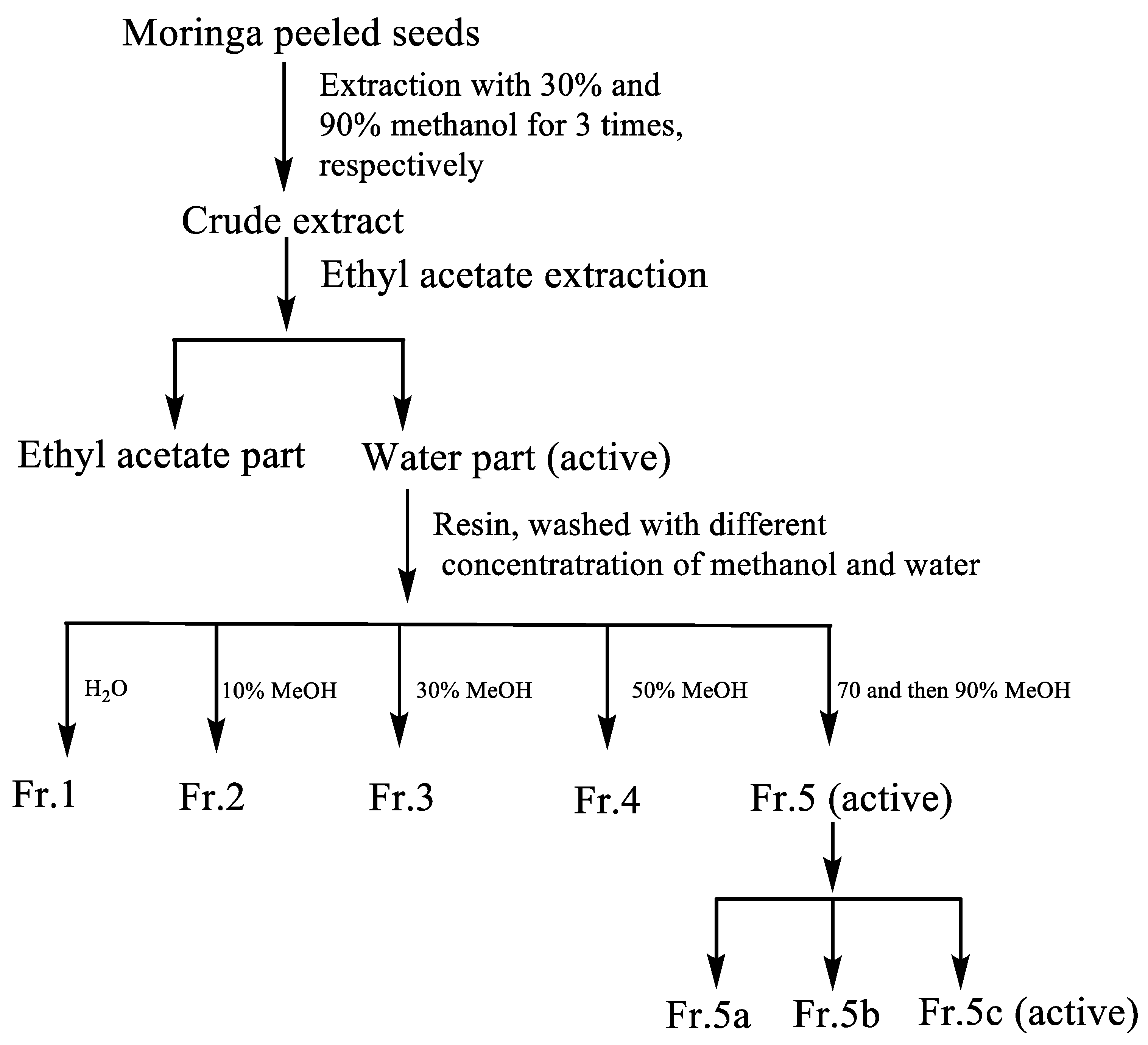
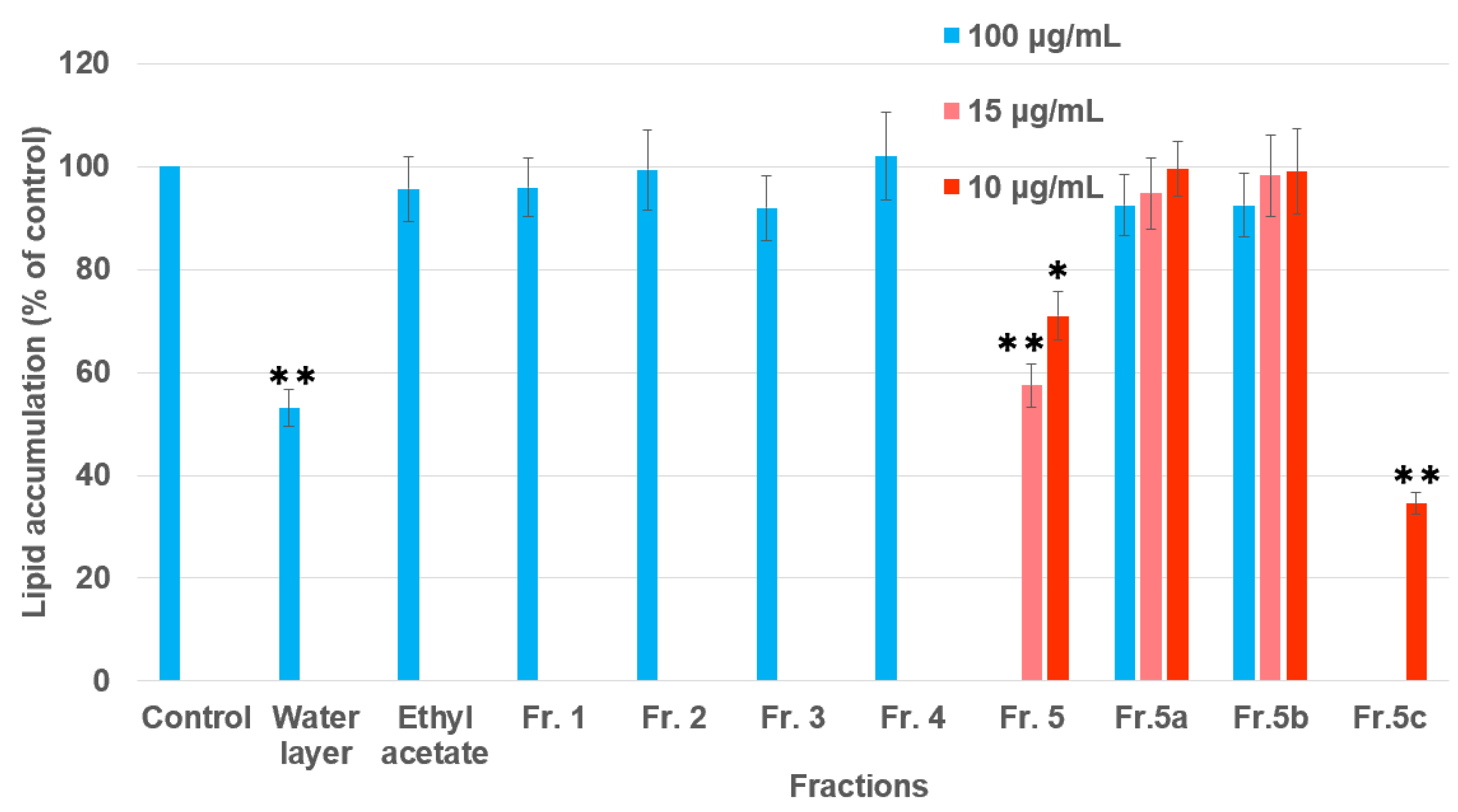
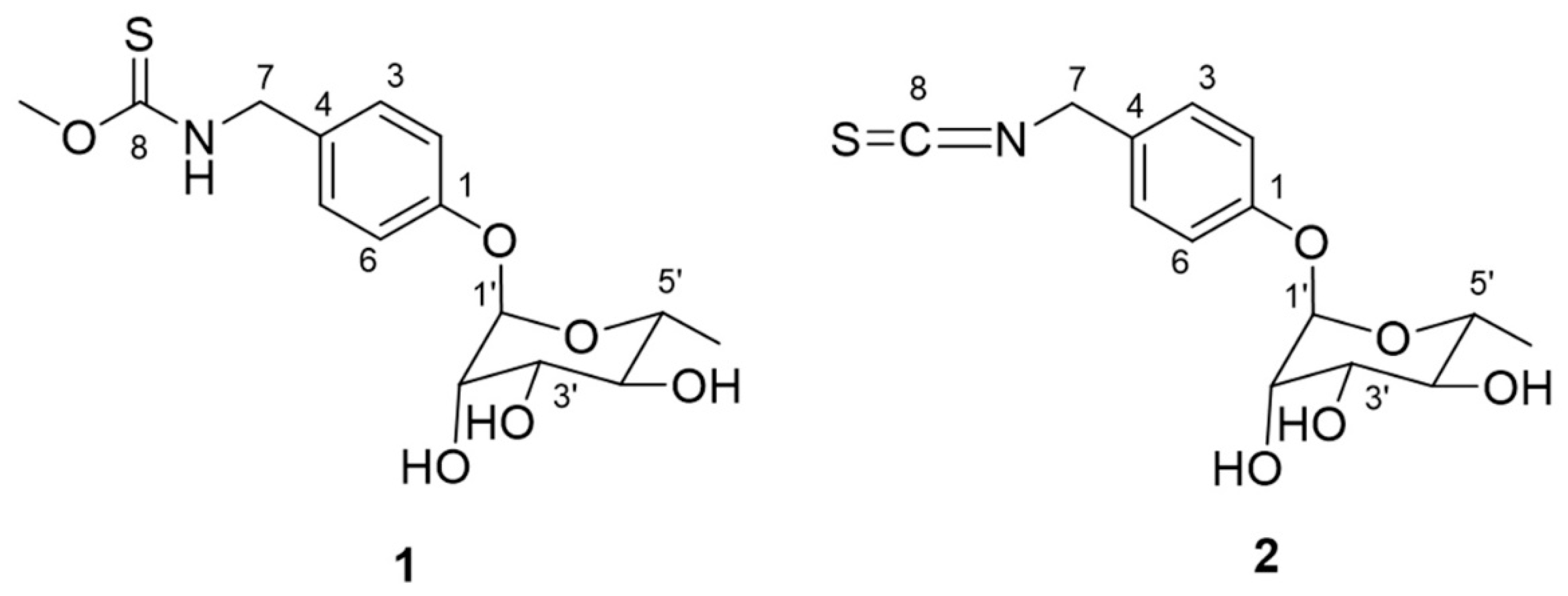
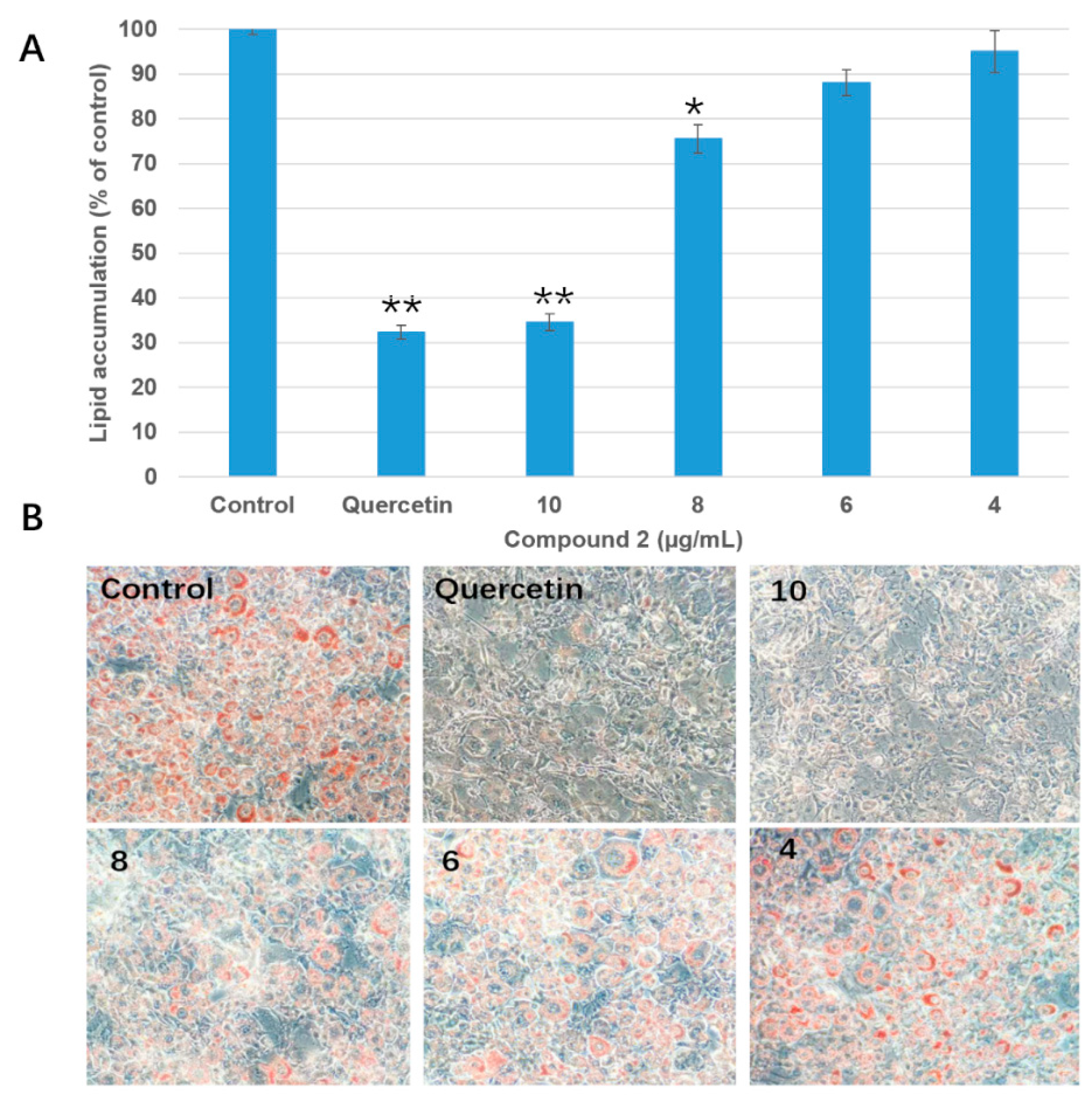
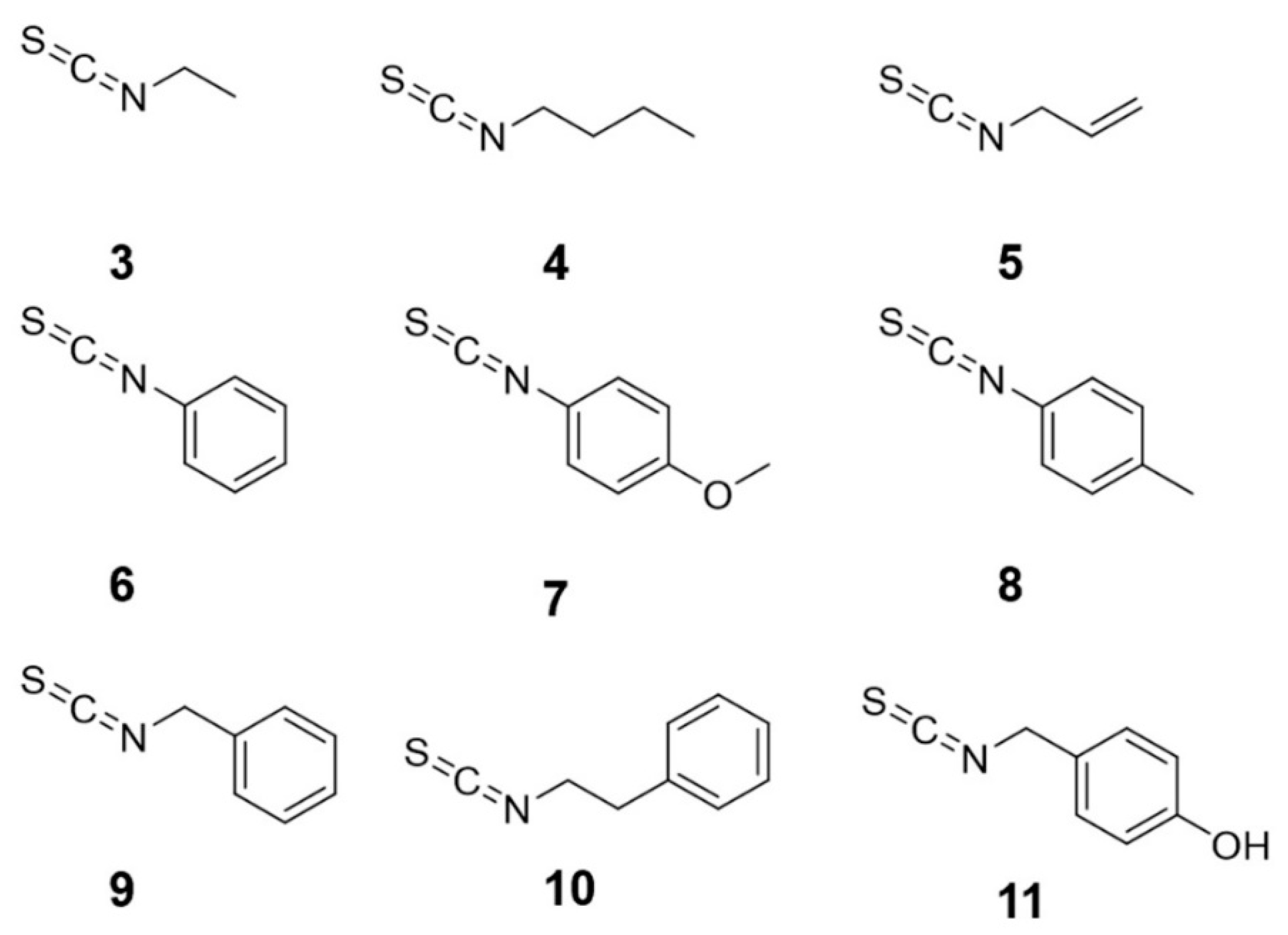
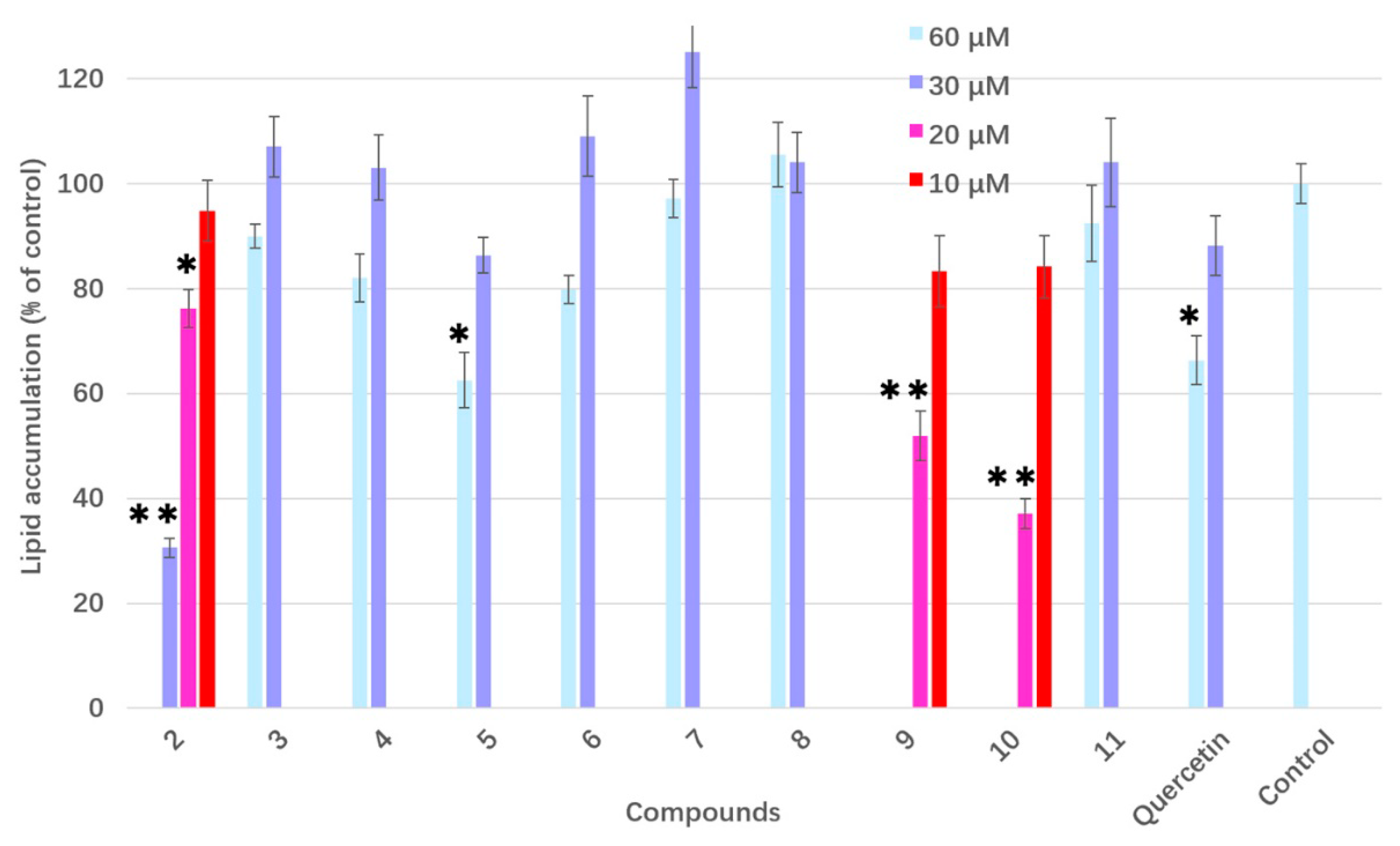
© 2020 by the authors. Licensee MDPI, Basel, Switzerland. This article is an open access article distributed under the terms and conditions of the Creative Commons Attribution (CC BY) license (http://creativecommons.org/licenses/by/4.0/).
Share and Cite
Huang, L.; Yuan, C.; Wang, Y. Bioactivity-Guided Identification of Anti-Adipogenic Isothiocyanates in the Moringa (Moringa oleifera) Seed and Investigation of the Structure-Activity Relationship. Molecules 2020, 25, 2504. https://doi.org/10.3390/molecules25112504
Huang L, Yuan C, Wang Y. Bioactivity-Guided Identification of Anti-Adipogenic Isothiocyanates in the Moringa (Moringa oleifera) Seed and Investigation of the Structure-Activity Relationship. Molecules. 2020; 25(11):2504. https://doi.org/10.3390/molecules25112504
Chicago/Turabian StyleHuang, Linhua, Chunmao Yuan, and Yu Wang. 2020. "Bioactivity-Guided Identification of Anti-Adipogenic Isothiocyanates in the Moringa (Moringa oleifera) Seed and Investigation of the Structure-Activity Relationship" Molecules 25, no. 11: 2504. https://doi.org/10.3390/molecules25112504
APA StyleHuang, L., Yuan, C., & Wang, Y. (2020). Bioactivity-Guided Identification of Anti-Adipogenic Isothiocyanates in the Moringa (Moringa oleifera) Seed and Investigation of the Structure-Activity Relationship. Molecules, 25(11), 2504. https://doi.org/10.3390/molecules25112504





